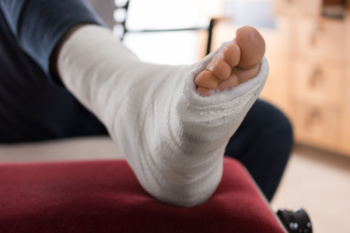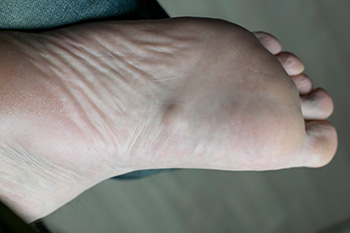Connect With Us
Items filtered by date: December 2024
Managing a Ruptured Achilles Tendon

A ruptured Achilles tendon is a significant injury where the thick tendon connecting the calf muscles to the heel tears, often during sudden, forceful movements. This injury is most common in men between 30 and 40 years of age, and frequently occurs during sports that involve explosive movements or quick direction changes, such as tennis, football, pickleball, and basketball. Patients often describe hearing a snapping or popping sound at the time of injury, followed by sharp pain and swelling at the back of the ankle. Walking becomes difficult, and standing on tiptoe is typically impossible. Early diagnosis is essential to determine the extent of the injury and the best course of treatment. A podiatrist can provide a thorough assessment and recommend appropriate care, which may include immobilization or supportive devices like walking boots. Addressing the injury promptly can improve recovery outcomes and help prevent further complications in the foot or ankle. If you have injured your Achilles tendon, it is suggested that you schedule an appointment with a podiatrist for an exam, diagnosis, and treatment.
Achilles tendon injuries need immediate attention to avoid future complications. If you have any concerns, contact Ali Davis, DPM of The Foot Clinic. Our doctor can provide the care you need to keep you pain-free and on your feet.
What Is the Achilles Tendon?
The Achilles tendon is a tendon that connects the lower leg muscles and calf to the heel of the foot. It is the strongest tendon in the human body and is essential for making movement possible. Because this tendon is such an integral part of the body, any injuries to it can create immense difficulties and should immediately be presented to a doctor.
What Are the Symptoms of an Achilles Tendon Injury?
There are various types of injuries that can affect the Achilles tendon. The two most common injuries are Achilles tendinitis and ruptures of the tendon.
Achilles Tendinitis Symptoms
- Inflammation
- Dull to severe pain
- Increased blood flow to the tendon
- Thickening of the tendon
Rupture Symptoms
- Extreme pain and swelling in the foot
- Total immobility
Treatment and Prevention
Achilles tendon injuries are diagnosed by a thorough physical evaluation, which can include an MRI. Treatment involves rest, physical therapy, and in some cases, surgery. However, various preventative measures can be taken to avoid these injuries, such as:
- Thorough stretching of the tendon before and after exercise
- Strengthening exercises like calf raises, squats, leg curls, leg extensions, leg raises, lunges, and leg presses
If you have any questions please feel free to contact our office located in Overland Park, KS . We offer the newest diagnostic tools and technology to treat your foot and ankle needs.
Broken Foot Basics

A broken foot happens when one of the 26 bones in the foot cracks or breaks. This injury can occur from accidents like dropping a heavy object on it, falling, or twisting the foot during sporting activity. Stress fractures, caused by repetitive strain, are another common type of foot break. Symptoms of a broken foot include swelling, bruising, pain when moving or bearing weight, and sometimes a visible deformity. Immediate care is critical to prevent worsening the injury. Treatment depends on the type and severity of the fracture. Minor breaks may only need rest and a supportive boot or cast. Severe fractures might require surgery with pins or plates to stabilize the bones. If you suspect you have broken your foot, it is suggested that you see a podiatrist for an accurate diagnosis and treatment plan to ensure proper healing and recovery.
A broken foot requires immediate medical attention and treatment. If you need your feet checked, contact Ali Davis, DPM from The Foot Clinic. Our doctor can provide the care you need to keep you pain-free and on your feet.
Broken Foot Causes, Symptoms, and Treatment
A broken foot is caused by one of the bones in the foot typically breaking when bended, crushed, or stretched beyond its natural capabilities. Usually the location of the fracture indicates how the break occurred, whether it was through an object, fall, or any other type of injury.
Common Symptoms of Broken Feet:
- Bruising
- Pain
- Redness
- Swelling
- Blue in color
- Numbness
- Cold
- Misshapen
- Cuts
- Deformities
Those that suspect they have a broken foot shoot seek urgent medical attention where a medical professional could diagnose the severity.
Treatment for broken bones varies depending on the cause, severity and location. Some will require the use of splints, casts or crutches while others could even involve surgery to repair the broken bones. Personal care includes the use of ice and keeping the foot stabilized and elevated.
If you have any questions please feel free to contact our office located in Overland Park, KS . We offer the newest diagnostic and treatment technologies for all your foot and ankle needs.
Metatarsalgia and Toe Pain

Metatarsalgia is characterized by pain and inflammation in the ball of the foot, often radiating into the toes. It occurs when excessive pressure is placed on the metatarsal bones, which bear much of the body’s weight during walking or running. High-impact activities, improper footwear like high heels or unsupportive shoes, foot deformities, or conditions such as arthritis or bunions can contribute to the development of metatarsalgia. The pain, often described as sharp, aching, or like walking on pebbles, can extend to the toes due to the close proximity of nerves and tissues. To manage metatarsalgia, rest, switch to supportive footwear with cushioning, and use insoles or padding to redistribute pressure. If pain persists, it is suggested that you consult a podiatrist for further evaluation and treatment to prevent the worsening of symptoms.
Toe pain can disrupt your daily activities. If you have any concerns, contact Ali Davis, DPM of The Foot Clinic. Our doctor can provide the care you need to keep you pain-free and on your feet.
What Causes Toe Pain?
Most severe toe pain is caused due to a sports injury, trauma from dropping something heavy on the toe, or bumping into something rigid. Other problems can develop over time for various reasons.
Toe pain can be caused by one or more ailments. The most common include:
- Trauma
- Sports injury
- Wearing shoes that are too tight
- Arthritis
- Gout
- Corns and calluses
- Hammertoe
- Bunions
- Blisters
- Ingrown toenails
- Sprains
- Fractures (broken bones)
- Dislocations
When to See a Podiatrist
- Severe pain
- Persistent pain that lasts more than a week
- Signs of infection
- Continued swelling
- Pain that prevents walking
Diagnosis
In many cases the cause of toe pain is obvious, but in others, a podiatrist may want to use more advanced methods to determine the problem. These can range from simple visual inspections and sensation tests to X-rays and MRI scans. Prior medical history, family medical history, and any recent physical traumatic events will all be taken into consideration for a proper diagnosis.
Treatment
Treatments for toe pain and injuries vary and may include shoe inserts, padding, taping, medicines, injections, and in some cases, surgery. If you believe that you have broken a toe, please see a podiatrist as soon as possible.
If you have any questions please feel free to contact our office located in Overland Park, KS . We offer the newest diagnostic tools and technology to treat your foot and ankle needs.
Exercising the Feet Is Part of Foot Care

Stretching and strengthening the feet are essential components of effective foot care. Regular stretching improves flexibility, reduces tension, and helps prevent conditions like plantar fasciitis and Achilles tendinitis, while strengthening exercises improve stability, balance, and endurance. These practices are especially beneficial for those with flat feet, high arches, or foot pain from activities like running, walking, or prolonged standing. A podiatrist plays an important role in guiding patients on safe and effective foot exercises tailored to their specific needs. They assess foot mechanics, identify areas of weakness or stiffness, and recommend personalized stretching and strengthening routines. Podiatrists may also use therapeutic tools like resistance bands and balance exercises to improve foot function. If you would like to improve the health of your feet, it is suggested that you see a podiatrist for guidance on such exercises that can reduce pain, prevent injuries, and improve mobility.
Stretching the feet is a great way to prevent injuries. If you have any concerns with your feet consult with Ali Davis, DPM from The Foot Clinic. Our doctor will assess your condition and provide you with quality foot and ankle treatment.
Stretching the Feet
Stretching the muscles in the foot is an important part in any physical activity. Feet that are tight can lead to less flexibility and make you more prone to injury. One of the most common forms of foot pain, plantar fasciitis, can be stretched out to help ease the pain. Stretching can not only ease pain from plantar fasciitis but also prevent it as well. However, it is important to see a podiatrist first if stretching is right for you. Podiatrists can also recommend other ways to stretch your feet. Once you know whether stretching is right for you, here are some excellent stretches you can do.
- Using a foam roller or any cylindrical object (a water bottle or soda can will do), roll the object under your foot back and forth. You should also exert pressure on the object. Be sure to do this to both feet for a minute. Do this exercise three times each.
- Similar to the previous one, take a ball, such as a tennis ball, and roll it under your foot while seated and exert pressure on it.
- Grab a resistance band or towel and take a seat. If you are using a towel, fold it length wise. Next put either one between the ball of your foot and heel and pull with both hands on each side towards you. Hold this for 15 seconds and then switch feet. Do this three times for each foot.
- Finally hold your big toe while crossing one leg over the other. Pull the toe towards you and hold for 15 seconds. Once again do this three times per foot.
It is best to go easy when first stretching your foot and work your way up. If your foot starts hurting, stop exercising and ice and rest the foot. It is advised to then see a podiatrist for help.
If you have any questions, please feel free to contact our office located in Overland Park, KS . We offer the newest diagnostic and treatment technologies for all your foot care needs.
Symptoms and Causes of Plantar Fibromatosis

Plantar fibromatosis, also known as Ledderhose disease, is a condition characterized by the growth of benign nodules or lumps in the connective tissue of the foot. These nodules form along the plantar fascia, the thick band of tissue that supports the arch of the foot. The primary symptoms of plantar fibromatosis include pain, discomfort, and the visible appearance of lumps on the bottom of the foot. In some cases, the lumps may become large enough to limit movement or cause difficulty walking. The exact cause of the condition is not fully understood, although genetics may play a role, as it tends to run in families. Other factors such as trauma or repeated injury to the foot may also contribute. If you have developed nodules on the sole of your foot, it is suggested that you consult a podiatrist who can offer a proper diagnosis and effective relief tips.
A plantar fibroma may disrupt your daily activities. If you have any concerns, contact Ali Davis, DPM of The Foot Clinic. Our doctor can provide the care you need to keep you pain-free and on your feet.
Plantar Fibroma
A plantar fibroma is a fibrous knot in the arch of the foot. It is embedded in the plantar fascia which is a band of tissue that extends from the heel to the toes along the bottom of the foot. There can be multiple plantar fibromas in the feet at the same time. There are no known causes for this condition. If you have a plantar fibroma, there will be a bump in the arch of your foot that cannot be missed. Any associated pain is most often due to a shoe rubbing against the nodule. Non-surgical options, such as steroid injections, physical therapy, and orthotics should be tried first. Surgery is a last resort and is the only thing that will remove a plantar fibroma entirely. Consult with a podiatrist for a proper diagnosis and to determine the treatment regimen that is right for you.
What Causes a Plantar Fibroma?
While there are no specific causes identified, a plantar fibroma can possibly come from genetic predisposition or the formation of scar tissue that forms from healing the tears in the plantar fascia.
What Are the Symptoms of a Plantar Fibroma?
There will be a noticeable lump in the arch of the foot that may or may not cause pain. If pain is felt, it is typically because a shoe is rubbing up against the lump or when walking or standing barefoot.
Treatment and Prevention
A plantar fibroma will not disappear without treatment, but it can get smaller and be a non-issue. If pain persists, a podiatrist examines the foot and when the arch of the foot is pressed, pain can be felt down to the toes. An MRI or biopsy might be performed to help diagnose or evaluate the plantar fibroma. The following non-surgical options are generally enough to reduce the size and pain of these nodules:
- Steroid injections
- Orthotics
- Physical therapy to help apply anti-inflammatory creams on the bump
Surgery is considered if the mass increases in size and the patient continues to feel pain after non-surgical methods are tried.
If you have any questions please feel free to contact our office located in Overland Park, KS . We offer the newest diagnostic tools and technology to treat your foot and ankle needs.
Arthritis Can Cause Pain in the Feet and Ankles
Blog Archives
- April 2025
- March 2025
- February 2025
- January 2025
- December 2024
- November 2024
- October 2024
- September 2024
- August 2024
- July 2024
- June 2024
- May 2024
- April 2024
- March 2024
- February 2024
- January 2024
- December 2023
- November 2023
- October 2023
- September 2023
- August 2023
- July 2023
- June 2023
- May 2023
- April 2023
- March 2023
- February 2023
- January 2023
- December 2022
- November 2022
- October 2022
- September 2022
- August 2022
- July 2022
- June 2022
- May 2022
- April 2022
- March 2022
- February 2022
- January 2022
- December 2021
- November 2021
- October 2021
- September 2021
- August 2021
- July 2021
- June 2021
- May 2021
- April 2021
- March 2021
- February 2021
- January 2021
- December 2020
- November 2020
- October 2020
- September 2020
- August 2020
- July 2020
- June 2020
- May 2020
- April 2020
- March 2020
- February 2020
- January 2020
- December 2019
- November 2019
- October 2019
- September 2019

